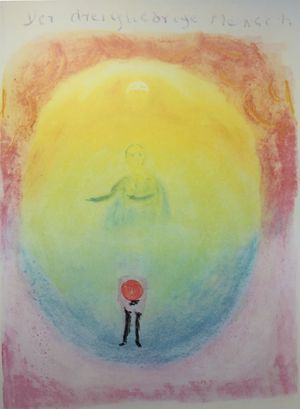Threefold structure of the human organism

The threefold structure of the human organism is a central principle of the anthroposophical study of man and was first explicitly presented by Rudolf Steiner in his book "Von Seelenrätseln" in 1917 (Lit.:GA 21).
„The nervous and sensory system, as it is centralised in the head, is in the human organism an independent member, existing for itself. What exists as the pulmonary and cardiac system, as the circulatory system, is in turn an independent member existing for itself. Likewise the metabolic system. You can read more about this in my book "Von Seelenrätseln". That is the characteristic feature of the human organism, that its systems unfold their right development and effectiveness precisely because they are not centralised, but because they exist side by side and work together freely. If today we cannot understand the human organism in this comprehensive, penetrating way, we certainly cannot understand the social organism with science, which has not yet been reformed, but which must be reformed in the spiritual-scientific sense. One believes today that the human organism is something centralised, whereas it is threefold.“ (Lit.:GA 328, p. 21)
The three systems of the human organism
Three very different systems of the human organism can be clearly distinguished:
The nerve-sense system is mainly centred in the head and is the physical tool for sensory perception, imagining and thinking. It provides the basis for the human being's alert daytime consciousness, which is devoted to the sensory world.
The rhythmic system includes breathing and circulation and is therefore appropriately centred in the chest area. It is the most essential physical tool of the emotional life and of the human language sounding in the living flowing breath. Every mood change, every joy, every sorrow is reflected in a slight change in breathing and an accelerating or decelerating pulse beat, just as every bodily change in breathing and heart rhythm immediately affects our emotional life. However, we do not experience these feelings as clearly and awake as what we experience through our nervous-sensory system. In our emotional life we are actually constantly dreaming.
The metabolic-limb system is fundamental to the unfolding of our will. In particular, the upright posture of the human being is also based in this system. The inner processes that take place remain even more unconscious to us. What actually happens in the depths of our organism when we walk upright through the world, or when we willingly grasp an object with our freed hands, largely eludes our consciousness. But it is precisely in this that the actual reality of the human will lies, and not in the mere mental imagination that accompanies it. In the will we are actually constantly asleep.
In animals, especially in the higher animals, this threefold structure of the organism is already clearly visible, but it is nowhere as well-balanced as in man. Only the finely tuned harmony with which these three systems, interpenetrating each other in a lively way, work together in man to makes his upright posture, articulate speech and rational thinking possible.
Literature
- Lothar Vogel: Der dreigliedrige Mensch: Morphologische Grundlagen einer allgemeinen Menschenkunde, 4. Auflage, Verlag am Goetheanum, Dornach 2005, ISBN 978-3723512302
- Wolfgang Schad: Säugetiere und Mensch: Ihre Gestaltbiologie in Raum und Zeit, Verlag Freies Geistesleben, Stuttgart 2012, ISBN 978-3772511509
- Rudolf Steiner: Von Seelenrätseln, GA 21 (1983), ISBN 3-7274-0210-5 English: rsarchive.org German: pdf pdf(2) html mobi epub archive.org
- Rudolf Steiner: Allgemeine Menschenkunde als Grundlage der Pädagogik, GA 293 (1992), ISBN 3-7274-2930-5 English: rsarchive.org German: pdf pdf(2) html mobi epub archive.org
- Rudolf Steiner: Heilpädagogischer Kurs, GA 317 (1995), ISBN 3-7274-3171-7 English: rsarchive.org German: pdf pdf(2) html mobi epub archive.org
- Rudolf Steiner: Die soziale Frage, GA 328 (1977), ISBN 3-7274-3280-2 English: rsarchive.org German: pdf pdf(2) html mobi epub archive.org
 |
References to the work of Rudolf Steiner follow Rudolf Steiner's Collected Works (CW or GA), Rudolf Steiner Verlag, Dornach/Switzerland, unless otherwise stated.
Email: verlag@steinerverlag.com URL: www.steinerverlag.com. Index to the Complete Works of Rudolf Steiner - Aelzina Books A complete list by Volume Number and a full list of known English translations you may also find at Rudolf Steiner's Collected Works Rudolf Steiner Archive - The largest online collection of Rudolf Steiner's books, lectures and articles in English. Rudolf Steiner Audio - Recorded and Read by Dale Brunsvold steinerbooks.org - Anthroposophic Press Inc. (USA) Rudolf Steiner Handbook - Christian Karl's proven standard work for orientation in Rudolf Steiner's Collected Works for free download as PDF. |
